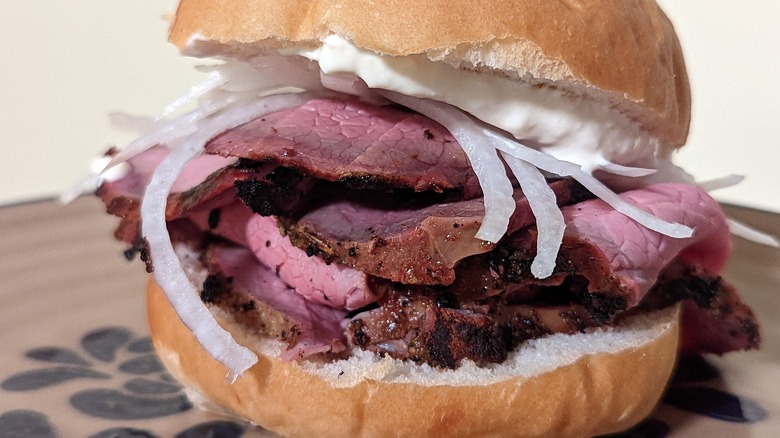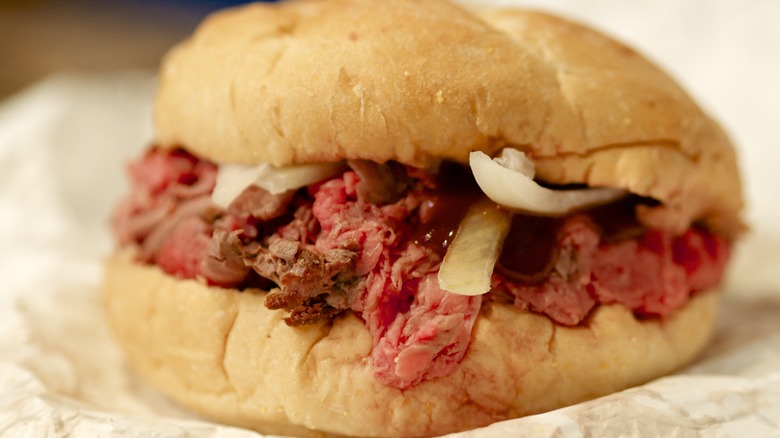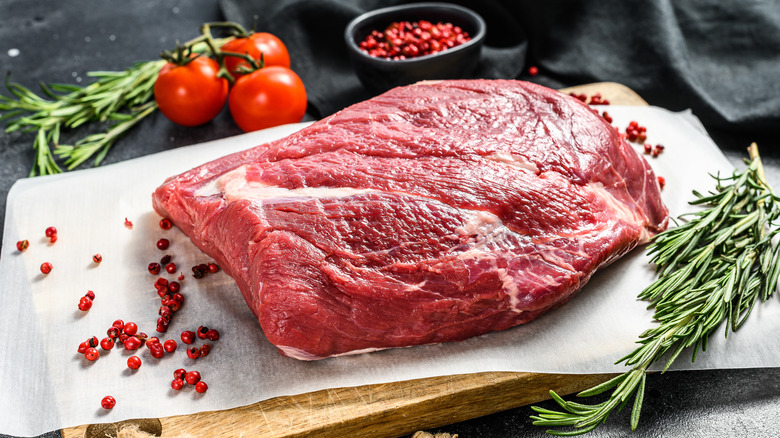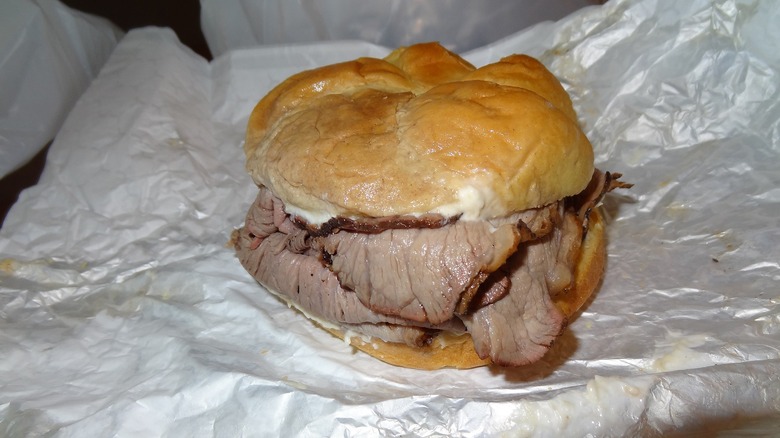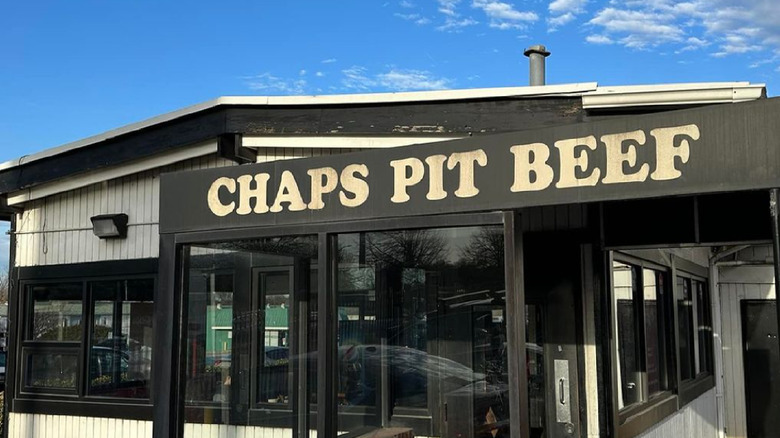What Is Pit Beef? The Barbecue Style For Rare Meat Lovers
Say the term barbecue, and likely foods like ribs, brisket, and sausages come to mind. However, the cooking method encompasses a far more extensive range of dishes. After all, barbecue is simply defined as food prepared over a live fire or charcoal — leaving room for many possibilities.
So with many different styles in the U.S., it's no surprise some renditions are highly regional. Take pit beef, for example. A beloved classic in Baltimore, the dish is more akin to roast beef than a rack of ribs. It is made with thin slices of top round, and the meat is cooked to a pink medium-rare and then finished on a smoky charcoal grill. You'll typically find it covered with raw onions and smeared with horseradish and served on a Kaiser roll — making the sandwich seem like a creation from a deli. Nevertheless, it's a delicious barbecue creation intertwined with Charm City.
Origins of pit beef
The exact origins are murky since there is no chef or establishment intertwined with the dish. However, evidence points to it emerging among affordable eateries lining Pulaski Highway, which runs Northeast of the city. The name pit beef was first coined in print in a 1968 ad for a tavern, but the food's popularity only accelerated later into the '70s.
Just as with its invention, the rationale for the beef's charcoal finish is smoky. Some speculate such a cooking method allowed the food to stand out among other sandwiches, An extra oomph was provided by the name, which was only coined down the line — originally, they were sold as roast beef sandwiches.
Even pit beef's inclusion in the barbecue canon is contentious. Some believe the dish to be a unique Baltimore style, while other enthusiasts hope to distinguish it from the world of slow cooking. The fact that many notable purveyors switched to gas over coals furthers its ambiguity. Regardless, it's become a celebrated classic.
How is pit beef made?
Of course, this sandwich style needs to start with the meat. While a large, several-pound chunk of top round is the most popular option, it can also be crafted with other cuts like bottom round and occasionally sirloin. Any excess fat is sliced off since it's necessary that the meat's texture is as uniform as possible.
Next, the exterior is coated in a dry rub. A coarser salt, like kosher, is utilized as the base, alongside flavorings like paprika, garlic powder, oregano, and black pepper. Rub mixes vary per preference, so feel free to experiment with desired flavors. The beef is then dry-brined for up to three days in the fridge.
In-home preparations, the dish is often prepared on a gas grill, with wood chips thrown in for extra smoky flavor. The cooking temperature is low — only around 225 degrees Fahrenheit. The goal is for the meat to develop a dark, crispy exterior crust while the interior remains rare. After only around half an hour, the beef is done. After a rest, the meat is sliced across the grain, which is a vital step to ensure it's as tender as possible. Some then finish the strips for a few minutes on the grill, while others consume them in their bright red, rare state.
How to eat pit beef
Upon ordering, pit beef can be requested at any interior temperature, like with a steak. However, to fully appreciate the style, order rare or medium rare since that juicy interior is what makes the style stand out.
Pit beef is enjoyed in sandwich form, in between slices of white or Kaiser bread. A generous amount of white onions are placed inside, along with another crucial accompaniment: a sauce. The most traditional choice is Tiger sauce, made from a just-slightly nostril-burning combination of horseradish and mayonnaise. However, classic barbecue sauce is another option, or a dollop of both is acceptable. Just make sure not to lather too much on, or else it'll overwhelm the tasty beef.
Frequently, the sandwich is accompanied by fries and served with gravy, which is a Maryland tradition. Eaten at no-frills eateries or taken to-go, acquiring pit beef doesn't require patience with other barbecue styles.
Notable pit beef restaurants
Baltimore and its nearby towns have a vast selection of pit beef eateries. Each one has its staunch supporters, so sample several to find one that aligns with your taste. A great place to start is Chap's — there's no pit beef joint quite as infamous. Opened in 1987, the always-bustling restaurant has several locations around Maryland. It's a spot that's garnered abundant media attention for its rendition of the sandwich and perfectly balanced Tiger sauce.
To sample a version a little more rustic and true to pit beef's roots, head to Baker's Pit Beef and Tavern. This restaurant opened in 1890 and has been serving pit beef since its origins in the '60s, inflected with a tinge of Greek technique. Washed down with a beer in the quaint decor, it's a showcase that sometimes the best food is left unchanged.
Another restaurant beloved in the city is Expressway Pit Beef. The top round is sliced a bit thicker, which gives it more of a body. Plus, the casual eatery also serves delicious renditions of other grilled meats, like smoked sausages. Piled all together, it makes for an especially carnivorous version of the sandwich.
